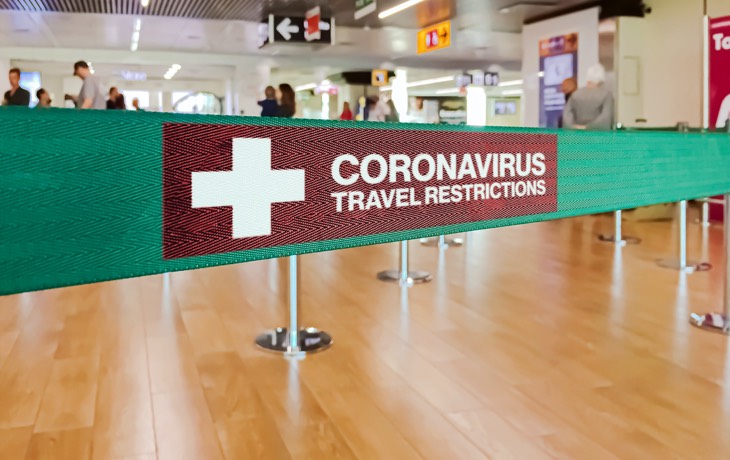Americans who are abroad and might wish to come back to the United States need to book their flights “immediately.” That’s the direction from Secretary of State Mike Pompeo. “We do not know how long the commercial flights in your countries may continue to operate,” Pompeo said at a press briefing on Tuesday. This is a real escalation in travel restrictions advised by the United States. And while it isn’t a travel ban, it does mean that flights chartered by the US government to get Americans home during the outbreak might not be available much longer.
All this comes just after the CDC issued a travel advisory for residents of New York, New Jersey, and Connecticut to “refrain from non-essential domestic travel” for 14 days on Sunday. Many immediately decried the travel advisory, saying it was redundant since all three states had already issued “stay at home” orders.
The question we’re all asking as we work from home, leaving only for food and exercise, is what exactly these travel restrictions accomplish. Are we even doing them right?
Scientists are trying to figure that out as fast as they can, and they might have had a breakthrough. A new study published on March 25 in Science Magazine by researchers in Boston, the UK, Ecuador, Seattle, Paris, Italy, and Beijing shows that travel restrictions work when they’re enforced early on in a pandemic, but their influence on the spread drops off dramatically after the virus has taken hold.
That might mean the restrictions in the United States are too little, too late. That doesn’t mean they’re worthless, but it does mean things are… complicated.
A Case Study: Wuhan, Hubei Province, China
The researchers first took a look at China, since that’s where the initial cluster of mysterious pneumonia cases were detected in late December 2019. Since then, the world has watched as cases spread from an epicenter in Wuhan, Hubei Province out to the rest of the world. Even after China locked down the city of Wuhan—in what seemed at the time to be an extreme measure—the virus continued to spread.
We now know that one of the major barriers to controlling the new coronavirus is the incubation period. That’s why it keeps spreading even after governments put lockdowns into effect. The average time a person goes between getting infected and showing symptoms is 5 days, but in some cases, the virus incubates for 14 days.
So in China, it took over a week for travel restrictions to make an impact after they were put in place. The data now shows that things got worse in the 5 to 7 days after the lockdown took effect, since local transmission and incubation periods had already started.
Recent research shows that the travel restrictions from Wuhan, Hubei Province came a little too late. But the mobility restrictions did help. The data suggests that early travel restrictions decreased the spread to other provinces in China. In late January, around 57% of people around China with the virus had traveled to Wuhan. After Wuhan was locked down on January 23, the virus started to incubate and spread among people who hadn’t traveled to Wuhan. The travel restriction made less of a difference than it would have if China had ordered it sooner.
But the restriction still made a dent! Researchers found 515 cases of COVID-19 in people who’d traveled to Wuhan and started experiencing symptoms before January 31. That number dropped all the way down to 39 cases after January 31, a week after the lockdown began. Great news, but the spread had already begun in other provinces. After the incubation period, cases exploded elsewhere.
Dr. Moritz Kraemer from the Oxford Programme on Pandemic Genomics at the University of Oxford studied the Chinese data. “However, once COVID-19 cases [began] spreading locally the contribution of new importations was much smaller,” Kraemer said in a press release. So other countries “need to consider carefully how they will manage reinstating travel and mobility to avoid the reintroduction and spread of the disease in their populations.”
Basically, we in the United States should have locked down a long time ago. Now that the virus has spread to all 50 states, these lockdowns could make less of a difference. True, the White House has extended COVID-19 travel guidelines and social distancing until the end of April, but the federal government shows no sign of locking down the whole country. Meanwhile, at least 32 states have issued “stay at home” orders.
Wait, how do we have this data about movement?
Just FYI, in case you missed that, yes our governments are using cell phone data to track our locations. Let’s zoom in on that for a second.
So far, the United States’ ability to track residents has been limited compared to what other countries are doing. Israel is using data from cell phone carriers to track residents’ movements and make sure they’re self-isolating. And mobile carriers in Italy, Germany, and Austria are also sharing location data with authorities. This data is anonymous and aggregated, so governments are using it to map ‘hot zones’ for COVID-19.
But in China, Taiwan, Hong Kong, and South Korea, where the virus took hold early, the government is using cell phone data to track individual citizens and enforce quarantine orders. A man was recently fined $33,000 in Taiwan for violating a quarantine order. Singapore is requiring recently returned citizens to share their location with authorities to prove that they’re self-isolating.
Scientists say our cell phone data could be essential to stopping the spread of coronavirus. We just might have to loosen our grip on our data for a while. The mobile data is key in establishing travel restrictions.
Former FDA Commissioner Scott Gottleib proposes doing exactly this in the US, a new report on how we can re-open the country:
The idea is to use phone apps tied to cell phones to help enforce isolation in people with known disease. South Korea, Israel already do this – with success. This is a key element of case-based interventions aimed at isolating individuals with disease to reduce spread. 2/6
— Scott Gottlieb, MD (@ScottGottliebMD) April 2, 2020
Crackdowns can hit again
Back to the travel bans. Whether countries keep using our data or not, the coronavirus could come back even after it settles down. And these lockdowns could come back too. Many scientists say we’re likely to see a resurgence of the coronavirus in countries where new infections seem to be under control right now.
It’s not time to lose hope, but it is time to stay home. The research does show that travel restrictions start to work again after the virus spreads for a while. And epidemiologists like Dr. Caitlin Rivers from Johns Hopkins Center for Health Security back that up. Dr. Rivers said in a tweet last week, “This is the moment I warned of – we have sacrificed so much already, but it feels like nothing is working. That’s because it takes weeks to see results. We must stay committed and trust that the social distancing we are enduring now will save thousands of lives.”

